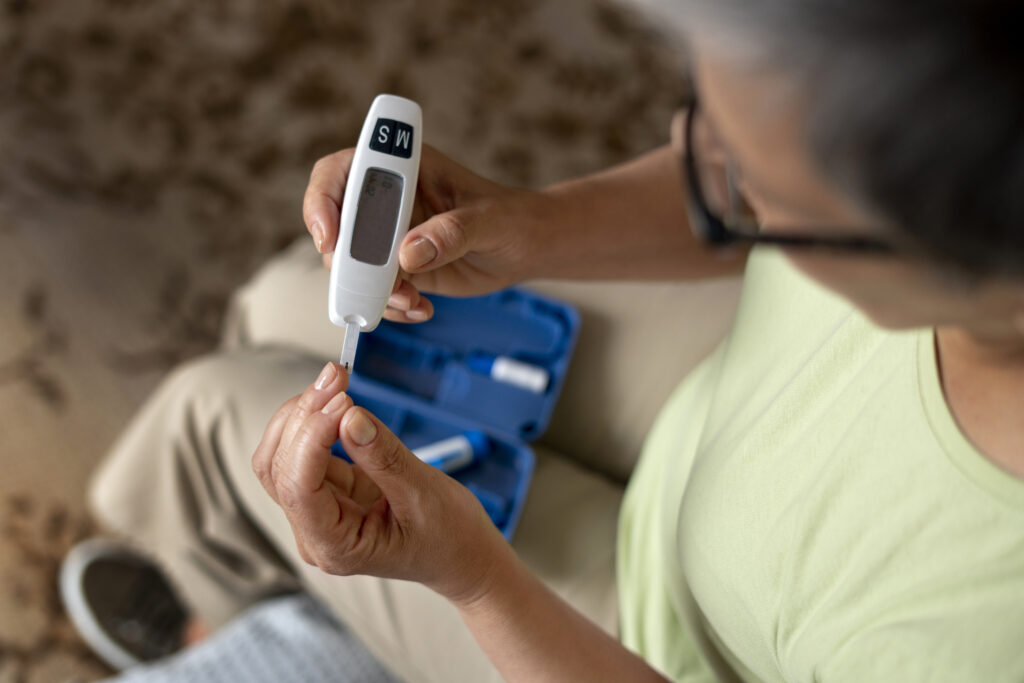Diabetes refers to a set of persistent metabolic ailments characterized by high dose of glucose in the circulatory system. When people think of diabetes, they often form an incorrect perception of diabetes being some condition that has negative effects on the way the body utilizes insulin which is a crucial hormone that controls the level of blood sugar. In this guide we shall delve into the real meaning of diabetes, will balance the causes, identify the symptoms, discover the different types and also the way it can be treated. But at least you will at least have something to go on so that you know how to control, prevent or treat it and this is a more worthwhile resource than most things on Google.
Understanding Main Types of Diabetes: Type 1, Type 2 & Gestational
Type 1 diabetes is an autoimmune disease in which immune system attacks insulin producing pancreatic cells. This creates the total deficiency of insulin and this necessitates a lifelong insulin treatment. It usually occurs in children, adolescents or young adults, its symptoms are sudden such as excessive thirst, weight drops and fatigability.
Type 2 diabetes it occurs in more than 90 per cent of cases. It develops due to insulin resistance- where there is an inability of muscle, fat and liver cells to effectively use insulin. Commonly aggravated by overweight, physical inactivity and unhealthy diet, the body first tries to adapt to these factors, first by secreting additional insulin. Gradually, the insulin synthesis reduces, which causes increasing the level of glucose in blood; therapy can start with lifestyle interventions however, in most cases it is accompanied with medications and, in some cases, insulin.
Gestational diabetes, is a condition that transpires during pregnancy, it emerges between weeks 24 and 28 due to the insulin resistivity that is caused as a result of the production of hormones by the placenta. Without treatment, it can lead to such complications as having excessively large childbirth weight and raising the risk of type 2 in both the mother and child in the future. It can manage the disorder through screening of regular glucose during pregnancy and lifestyle mechanisms, or through insulin when necessary.
Less Common Forms: LADA & MODY
LADA (Latent Autoimmune Diabetes in Adults) is also known as insidious (adult-onset type 1). It is similar to type 1 but advances at a slower rate among the adults. Usually patients respond to oral drugs and then later they develop dependency to insulin as the process of autoimmune destruction goes on.
MODY (Maturity-Onset Diabetes of the Young) is a family of typical rare monogenic diabetes. Starting before age 25, MODY is caused by single gene mutations that damage insulin production. Unlike type 1 or 2, most cases are not related to obesity or insulin resistance, in which gene-based therapy—will be an oral medication is used.
Root Causes & Risk Factors
Several core factors drive diabetes development:
- Genetics: Family history significantly influences risk for both type 1 and type 2. Specific genetic mutations heighten susceptibility.
- Autoimmune reactions: The immune system mistakenly targets pancreatic beta cells, leading to insulin deficiency in type 1 and LADA.
- Insulin resistance: Triggered by obesity—particularly central adiposity—poor diet, and sedentary lifestyle, this lays the foundation for type 2.
- Metabolic syndrome: A cluster of hypertension, high blood sugar, excess waist fat, and abnormal cholesterol levels significantly raises type 2 risk.
- Hormonal changes: During puberty, pregnancy, aging, or due to medications like corticosteroids, hormonal shifts can trigger or worsen diabetes.
Lifestyle, environmental, and genetic factors often intertwine, making early detection critical.
Symptoms: When To Get Checked
Early diagnosis is essential to prevent serious complications. Watch for:
- Excessive thirst and urination due to kidneys flushing out extra glucose
- Unusual hunger even after meals, from glucose not reaching cells
- Fatigue and irritability caused by cells starving from glucose deprivation
- Blurry vision from osmotic pressure shifts in the eye
- Slow wound healing, frequent infections, or numbness due to nerve and vascular damage
These symptoms may appear suddenly in type 1 but sneak up in type 2. Regardless of type, do not ignore them, especially with risk factors.
Diagnosing Diabetes: Tests & Interpretation
Diagnosis relies on accurate testing:
- Fasting blood glucose: A level ≥126 mg/dL on two occasions confirms diabetes.
- Hemoglobin A1C test: Measures average blood sugar over ~3 months. ≥6.5% indicates diabetes, while 5.7–6.4% suggests prediabetes.
- Oral Glucose Tolerance Test (OGTT): After a glucose drink, blood is tested at 2 hours. A reading ≥200 mg/dL defines diabetes; 140–199 mg/dL indicates prediabetes.
Regular diabetes screening is advised for overweight adults over 45, anyone with family history, or those with metabolic syndrome.
Role of Insulin & When It’s Required
Insulin Energy regulation is important in the regulation of glucose storage, usage and is important. In type 1 and severe type 2 insulin is synthesized in the pancreas in insufficient quantities. Then one can manage it through:
- Basal insulin: Long-acting injections or pump to maintain stable background levels
- Bolus insulin: Taken at meals to manage carbohydrate intake spikes
Promising technologies, such as continuous glucose monitors (CGMs) and insulin pumps, provide the benefit of increasing the dosage of insulin and minimizing a risk of complications. Patients have to acquire the knowledge of dosage calculations, carb counts, and adjustments.
Medication Strategies Beyond Insulin
When lifestyle isn’t enough, several oral and injectable medications help regulate blood sugar:
- Metformin: First-line medication, reduces liver glucose production, improves insulin sensitivity, typically well-tolerated.
- SGLT2 inhibitors: Cause glucose excretion in urine, aiding weight loss and protecting kidneys and the heart.
- GLP-1 receptor agonists: Slow digestion, reduce appetite, and boost insulin release post-meals.
- DPP-4 inhibitors, sulfonylureas, thiazolidinediones: Each targets blood sugar control differently, often used in combination with other drugs.
- Insulin analogs: Advanced forms (e.g., glargine, lispro) offer precise blood sugar management with fewer side effects.
Protocols are prescribed according to blood sugar goals, weight, prior conditions, age and cost.
Nutrition: Meal Planning for Stable Blood Sugar
Good diabetes nutrition focuses on:
- Carbohydrate monitoring: Track carbs using meal logs or apps.
- Glycemic index choices: Favor complex carbs—whole grains, legumes, vegetables—over refined ones.
- Balanced meals: Combine lean protein, healthy fats, fiber, and carbs for better blood sugar control and satiety.
Sample daily meals:
- Breakfast: Greek yogurt parfait with nuts and berries
- Lunch: Quinoa spinach salad topped with grilled chicken and olive oil
- Dinner: Stir-fried tofu with colorful veggies and brown rice
Avoid sugary drinks, processed snacks, and ultra-refined desserts to maintain steady glucose.
Physical Activity to Improve Glucose Control
Regular exercise boosts insulin sensitivity and supports weight management. Recommended:
- 150 minutes of aerobic activity weekly: such as brisk walking, cycling, swimming
- Strength training twice weekly: using weights or resistance bands to build muscle
- Daily movement breaks: stand and stretch frequently to counter sedentary habits
Exercise changes how the body uses glucose and impacts medication needs—always monitor your blood sugar before, during, and after workouts.
Home Monitoring: Tools & Best Practices
Self-monitoring puts you in control. Essential tools include:
- Finger-stick glucometer: Provides snapshot readings
- CGMs: Offer minute-by-minute insights into glucose trends and notify you of highs and lows
Track:
- Fasting, pre-meal, post-meal, bedtime readings to uncover patterns
- How food, exercise, stress, and insulin affect your numbers
Sharing these logs with your healthcare provider leads to smarter treatment adjustments.
Preventing Diabetes Complications
Managing blood sugar minimizes health risks, but vigilance is still needed:
- Foot care: Daily inspection, proper footwear, and immediate wound care prevent infections.
- Eye health: Annual retinal exams help early detection of diabetic retinopathy.
- Kidney monitoring: Albuminuria tests and regular kidney function checks safeguard renal health.
- Heart screening: Monitor blood pressure, cholesterol, and address cardiovascular risks.
Control of blood pressure, cholesterol, and avoidance of smoking are essential here.
Avoiding Type 2 Diabetes Through Lifestyle
Prediabetes is a warning sign—but change is possible:
- Lose 5–7% of body weight through diet and exercise to lower diabetes risk by about 58%
- Follow evidence-based programs like the CDC’s Diabetes Prevention Program (DPP)
- Adopt lasting habits: reduce sugary food intake, increase whole foods, and keep physically active
Small, consistent steps can prevent type 2 from developing.
Thriving with Diabetes: Daily Life & Emotional Health
Having healthy life with diabetes means much more than treating it physically; it reaches out to daily activities and psychological comfort:
- Education and support: Diabetes self-management education (DSME) teaches carb counting, insulin dosing, and preventing complications.
- Emotional care: Peer support and mental health resources help combat “diabetes burnout.”
- Smooth travel and work: Travel-friendly packaging for insulin, snacks, supplies, and wearing diabetes ID can prevent emergencies.
Living well means integrating diabetes care seamlessly into life—not letting it define you.
Conclusion
This all-in-one guide is meant to become your guide of choice- Diabetes in Las Vegas: What It Is, Causes, Symptoms, Treatment & Types. Being at risk, newly diagnosed, or having long-lasting experiences in dealing with diabetes, the main idea is more about knowledge, prevention, and rather active care. Do something: check with a medical practitioner, screen where necessary and make a change in your lifestyle today. With the proper equipment and assistance, you can lead a full life and be sure you have diabetes. To schedule your appointment with the highest standard of care, visit Sahara West Urgent Care on our website, where you can also explore more informative blogs.
FAQs
Can diabetes really be reversed?
Type 2 can be put into remission with sustained weight loss, healthy eating, and exercise. Type 1, LADA, and MODY require lifelong management and sometimes insulin.
How often do I need to test my blood sugar?
Depends on your condition and treatment. Those on insulin usually check several times daily; others may test less often. Follow your diabetes care team’s guidance.
Is diabetes hereditary?
Genetics plays a key role, especially in type 1 and MODY. Type 2 risk increases with genetics but is heavily influenced by lifestyle and weight.
What are the most important early symptoms?
Increased thirst, hunger, urination, fatigue, blurry vision, and poor wound healing. If you notice any combination, get a glucose test.
Will diabetes stop me from living a normal life?
Not at all. With proper management, support, education, and care, individuals with diabetes lead full, active, long lives.





